My most recent obsession has been contemplating/meditating on the second to last image from the
Rosarium Philosophorum (small colored images are linked directly from Adam McLean's Alchemy Website):
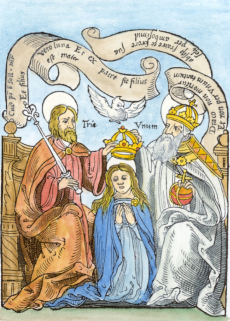
The final 4 emblems of the 20 emblem sequence in order are:
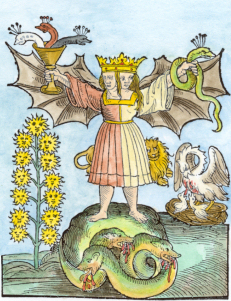
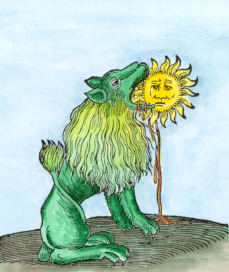

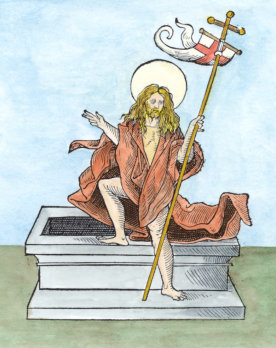
The 19th emblem depicts the crowning of Mary by the Holy Trinity. But here, Mary is meant to represent something beyond the conventional Christian definitions. She is in many ways more of a Sophia figure (for instance, as described in the story Kafiri posted
here) than the conventional Catholic Mary. That is she is the anima mundi or the spirit trapped in matter that is extracted/distilled/exalted/raised up alchemically (redeemed by Jesus, in the above) . . . but then purified, processed, and re-fixed/instilled back into matter. Thus, she represents the redemption and re-valuation of matter.
This also associates the figure with the alchemical Mercury and its process of transmutation from prima materia into the white and red stones or tinctures. And so, as Mercury, she is also Luna, the embodiment of the Feminine.
The first emblem depicting the coronation strikes me as a "crowning of Matter" . . . in my more sciencey, modernized interpretation, this would be akin to the conscious acknowledgment and understanding that Matter itself possesses, in a potential (the alchemists might say, "corrupted") state, all of human spirituality, intelligence, and consciousness (as governed by our instincts). I would see this as a Matter that is the elemental basis of psyche. To "crown Matter" in the sense this emblem portrays would be to consciously embrace the phylogenetic, instinctual unconscious as the essential basis of human consciousness. In other words, the ego must be devoted (as in Mary's posture of devotion/prayer) to facilitating the instinctual unconscious
in the world, in Matter.
The importance of this humbled, devotional stance (toward the instinctual unconscious/Self) is also borne out by the previous emblem, the green lion devouring the sun. Coming after the so called "demonstration of perfect" and creation of the red stone, the green lion symbol demonstrates that the philosophical gold created can still be consumed by Nature's appetite, by hydrochloric acid/aqua regia, or by philosophical Mercury. I have been seeing this as a sacrifice of "ego-credit" for the Work . . . but also as an acknowledgment that the Work is meant to feed and nourish the instinctual unconscious (it is raw material for the Self, just as the instinctual unconscious is raw material for the willful ego). The Work is not meant to "strengthen" or deify or in any way exalt the ego . . . but to facilitate the libido of the instinctual unconscious.
The entire second opus (as depicted in the Rosarium emblem sequence) is filled with symbols of sacrifice of spiritual achievements. First the alchemical hermaphrodite conjoined, purified, and reanimated in the first opus (the creation of the white stone) is (at least partially) divided so that the spiritualized (winged) Sol or sulfur can be dissolved in the mercurial bath again:
(The Mylius version more clearly shows this separation)
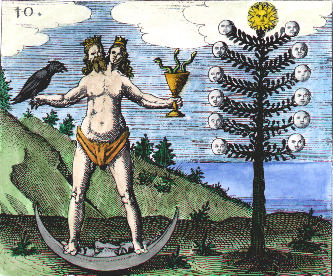
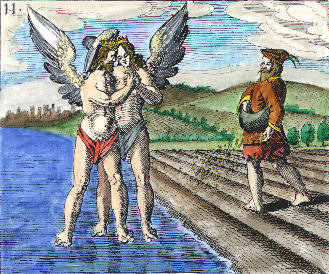
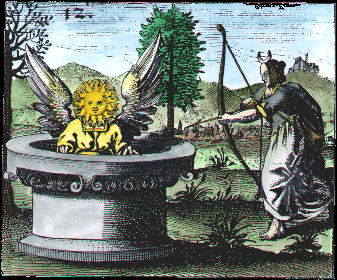
(In the original version, the lovers are subtly withdrawing from one another's embrace)
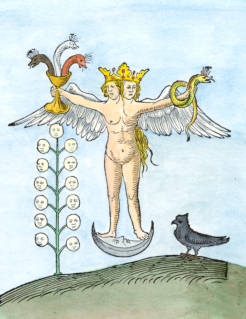
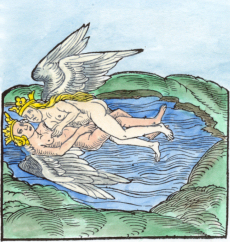
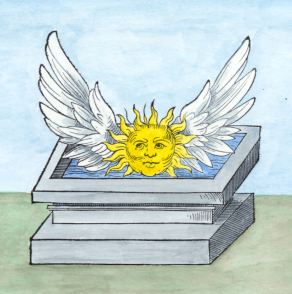
Sol and Luna are then reunited into one being, but (as in the first opus) this hermaphrodite is now a corpse . . . and its remaining spiritual principle must be dissolved/sacrificed so that it can be prepared for reanimation. When that reanimation occurs, the risen hermaphrodite has lost its white, angelic wings (a symbol of the transcendent spiritual principle). These are replaced by a contrasting style of wings: dragon. The dragon is usually associated with the prima materia in its chaotic state, which the alchemist tries to subdue and transform into an ordered principle. But with dragon's wings, the rebis would seem to have successfully integrated this re-organized/redeemed prima materia. We might say its ability to transcend or lift up now is entirely an aspect of material Nature . . . or that any transcendence is done within the framework of Nature and Matter rather than in opposition to it.
This is further borne out by other symbols in the 17th emblem, the "demonstration of perfection". Firstly, the ground on which the rebis stands is a depiction of the unredeemed, chaotic Matter (as three-headed dragon devouring itself . . . perhaps also a reference to the interaction of the three alchemical substances: sulfur, mercury, and salt). Note this Matter is an earthy mound and not the celestial moon crescent that suspends the rebis in the parallel 10th emblem (the creation of the white stone or lunar consciousness . . . that Jung used to portray the completion of the process). Next, there is a lion partially concealed behind the rebis. This could have numerous meanings, but it seems to generically indicate that a powerful, active yet instinctual (animal) force is behind (and under the control of or subordinated to) the rebis (also, Mylius depicts the lion held on a leash in the same emblem). Since the lion is located just below the waist/loin level of the rebis, this might further suggest that this instinctual force is generative or fecund. Finally, the symbol of the pelican feeding its young with blood from its own breast is a Christ-like self-sacrifice symbol.
A rather subtle aspect of that last symbol is that it is contrasted (spatially juxtaposed) with the sun tree on the left of the rebis. The sun tree is a reproductive/creative outgrowth or production of this stage of the Work. But the pelican symbol is clearly depicted as on a higher ground than this sun tree . . . as if to say that this "demonstration of perfection" (and the final product of the second opus) is more a matter of self-sacrifice than of production or achievement. Or alternatively, the higher/right side shows the active/conscious attitude of self-sacrifice while the lower/left side shows the passive/unconscious attitude of fruitfulness.
With all of these sacrifice symbols in the emblems of the second opus, it seems beyond doubt that this was a (if not the) central theme of this leg of the Work (as far as the creator of the
Rosarium sequence was concerned).
The alchemical process depicted in the coronation emblem, the 19th, (seen psychologically) is, I think, a reflection of the impregnation of Mary by God/the Holy Spirit. That is, Luna/Mercury appears here in the form of humble/devout Mary because her "holiness"/valuation (or redemption in the alchemical context) allows her to be a vessel for the divine. She is the impregnable Mater/Matter through which the incarnation of God in matter can be achieved.
I am thinking that this facilitating, receptive relationship of the ego with the instinctual Self in the material realm is also what is at times depicted as the
filius philosophorum. The
filius is still a symbol of potential, or of an attitude. It is birthed, but is not yet grown. In this sense, it could be associated with the devotional posture of Mary . . . for the filius is the product of such devotion. The actualization or implementation of the devotional, nurturing "
filius attitude" is depicted in the final emblem as the risen Christ. But that kind of incarnation is not the product of the ego, per se . . . but of the Self working through the receptive "filius attitude" embodied by the Virgin in receptive devotion.
I would say, then, that the filius and/or Virgin is a symbol of the alchemists' attitudinal goal. The ego doesn't "become" the
filius, but adopts the attitude the Virgin takes toward the reception of the Holy Spirit . . . immaculately conceiving, birthing, and nurturing the
filius, the conduit through which the libido of the Self moves into the world. The
filius is equally an attitude/conduit through which the world (and others or their Eros) is received.
The close connection between the filius and the Virgin Mother seems to be illustrated in the Mylius' recreation of the Rosarium sequence. In the same (19th) emblem, we see the filius crowned rather than Mary (the Mylius' emblems appear to be de-Christianized).
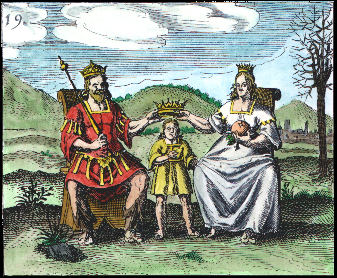
Here is a "more alchemical" version of this same emblem from the Pandora sequence by Reusner:

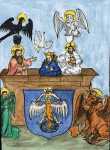
I say "more alchemical" because of the lower symbol, which seems to depict the extraction/exaltation of spirit from Matter that mirrors the upper symbol of the instillation of exalted spirit into Matter. The lower symbol may also be intended to represent a self-assisted birthing process of the spirit from Matter. I can't make out the not very well drawn (and also fairly bizarre) figures below to determine who they are meant to represent. The extractor seems to be female, so we could assume Luna/Mercury in one of her guises. The extracted semi-human form looks more male. One of the versions above depicts him with stigmata, so he would seem to correspond to the crucified Christ or the earthen Christ as Jesus who died and must be resurrected.
These two processes together form the completion of the Work (as depicted in the final emblem).